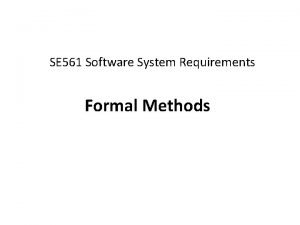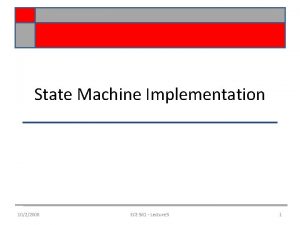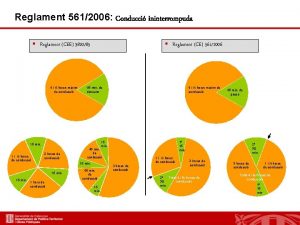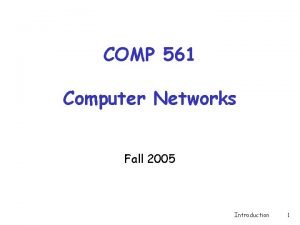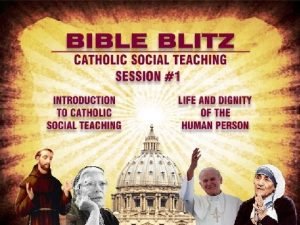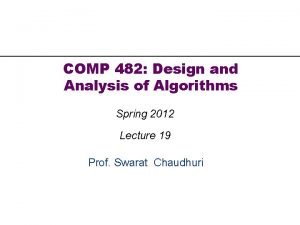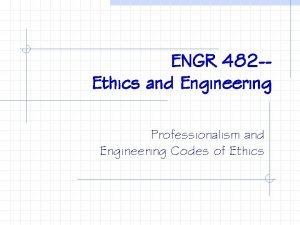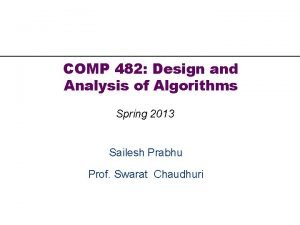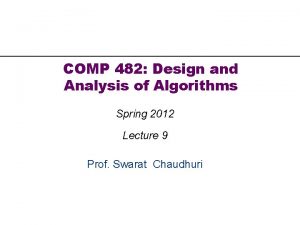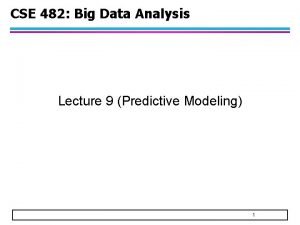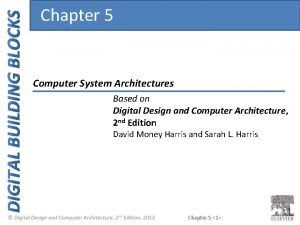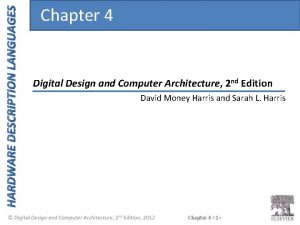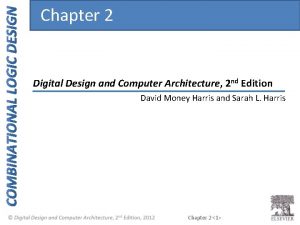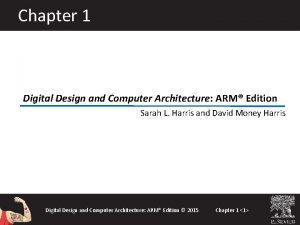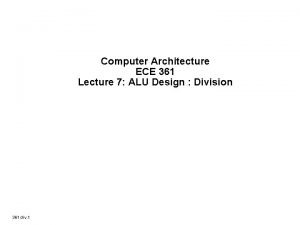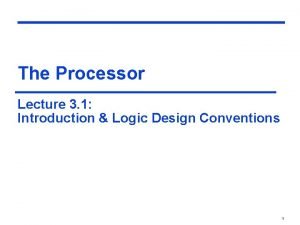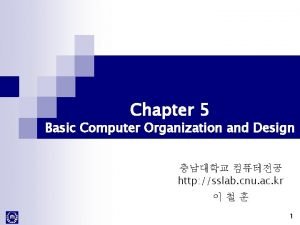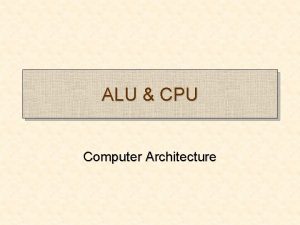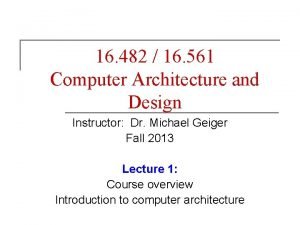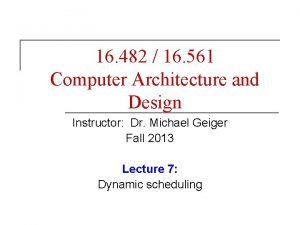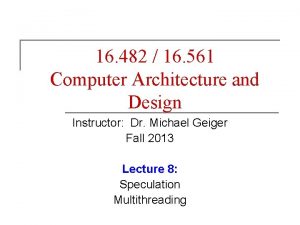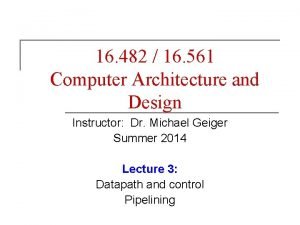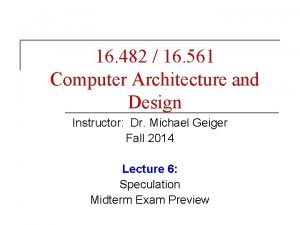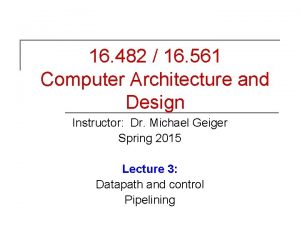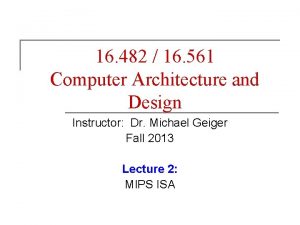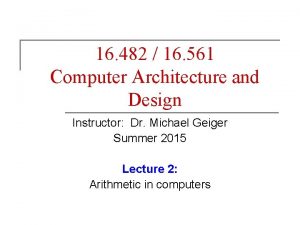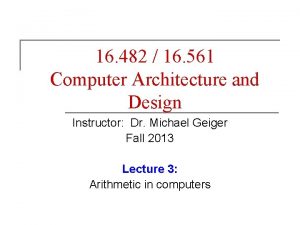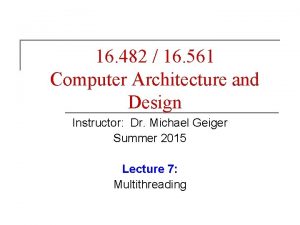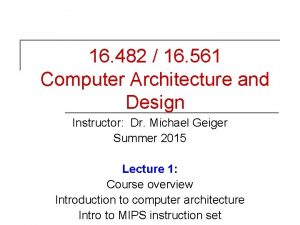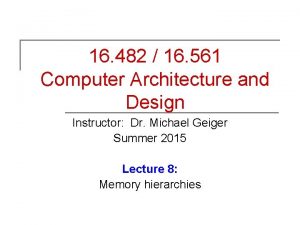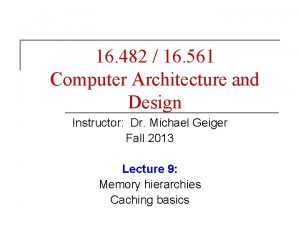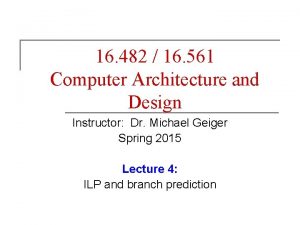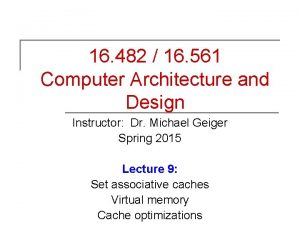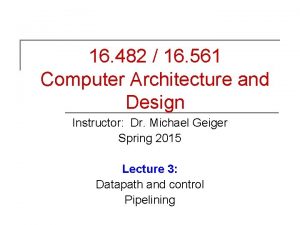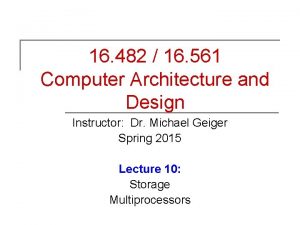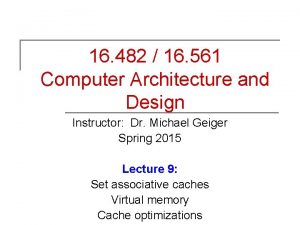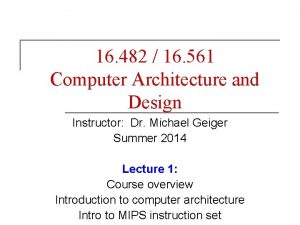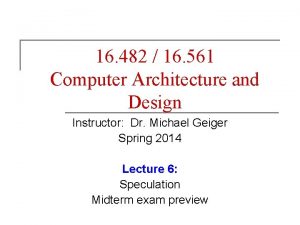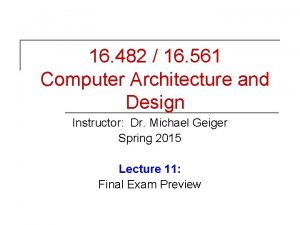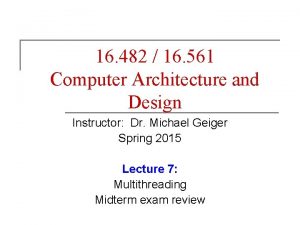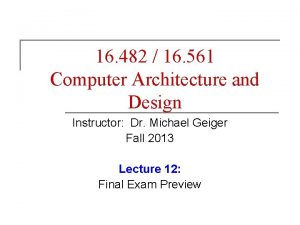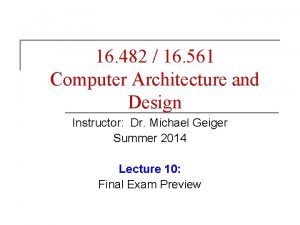16 482 16 561 Computer Architecture and Design






























![Correlating example (cont. ) n First access q q Global history = 01 entry[1] Correlating example (cont. ) n First access q q Global history = 01 entry[1]](https://slidetodoc.com/presentation_image_h2/8f93ed9178be6916370708fae6c06fc2/image-31.jpg)
![Correlating example (cont. ) n Third access q q Global history = 11 entry[3] Correlating example (cont. ) n Third access q q Global history = 11 entry[3]](https://slidetodoc.com/presentation_image_h2/8f93ed9178be6916370708fae6c06fc2/image-32.jpg)




- Slides: 36

16. 482 / 16. 561 Computer Architecture and Design Instructor: Dr. Michael Geiger Fall 2014 Lecture 4: ILP and branch prediction

Lecture outline n Announcements/reminders q q n Review q q q n HW 3 due today HW 4 to be posted; due 10/2 Basic datapath design Single-cycle datapath Pipelining Today’s lecture q q 9/7/2021 Instruction level parallelism (intro) Dynamic branch prediction Computer Architecture Lecture 4 2

Review: Simple MIPS datapath Chooses PC+4 or branch target Chooses ALU output or memory output Chooses register or sign-extended immediate 9/7/2021 Computer Architecture Lecture 4 3

Review: Pipelining n Pipelining low CPI and a short cycle q q q n Simultaneously execute multiple instructions Use multi-cycle “assembly line” approach Use staging registers between cycles to hold information Hazards: situation that prevents instruction from executing during a particular cycle q q Structural hazards: hardware conflicts Data hazards: dependences cause instruction stalls; can resolve using: n n q Control hazards: must wait for branches n 9/7/2021 No-ops: compiler inserts stall cycles Forwarding: add hardware paths to ALU inputs Can move target, comparison into ID only 1 cycle delay Computer Architecture Lecture 4 4

Review: Pipeline diagram lw add beq sw n Cycle 1 2 3 4 5 IF ID EX MEM WB IF ID EX MEM 6 7 8 WB Pipeline diagram shows execution of multiple instructions q q 9/7/2021 Instructions listed vertically Cycles shown horizontally Each instruction divided into stages Can see what instructions are in a particular stage at any cycle Computer Architecture Lecture 4 5

Review: Pipeline registers n n Need registers between stages for info from previous cycles Register must be able to hold all needed info for given stage q n For example, IF/ID must be 64 bits— 32 bits for instruction, 32 bits for PC+4 May need to propagate info through multiple stages for later use q 9/7/2021 For example, destination reg. number determined in ID, but not used until WB Computer Architecture Lecture 4 6

Branch Stall Impact n n If CPI = 1, 30% branch, Stall 3 cycles => new CPI = 1. 9! Two part solution: q q n n Determine branch taken or not sooner, AND Compute taken branch address earlier MIPS branch tests if register = 0 or 0 MIPS Solution: q q q 9/7/2021 Move Zero test to ID/RF stage Adder to calculate new PC in ID/RF stage 1 clock cycle penalty for branch versus 3 Computer Architecture Lecture 4 7

Four Branch Hazard Alternatives n n #1: Stall until branch direction is clear #2: Predict Branch Not Taken q q q n Execute successor instructions in sequence “Squash” instructions in pipeline if branch actually taken Advantage of late pipeline state update 47% MIPS branches not taken on average PC+4 already calculated, so use it to get next instruction #3: Predict Branch Taken q q 53% MIPS branches taken on average But haven’t calculated branch target address in MIPS n n 9/7/2021 MIPS still incurs 1 cycle branch penalty Other machines: branch target known before outcome Computer Architecture Lecture 4 8

Four Branch Hazard Alternatives #4: Delayed Branch q Define branch to take place AFTER a following instruction branch instruction sequential successor 1 sequential successor 2. . . . sequential successorn branch target if taken q q 9/7/2021 Branch delay of length n 1 slot delay allows proper decision and branch target address in 5 stage pipeline MIPS uses this Computer Architecture Lecture 4 9

Delayed Branch n Compiler effectiveness for single branch delay slot: q q q n Fills about 60% of branch delay slots About 80% of instructions executed in branch delay slots useful in computation About 50% (60% x 80%) of slots usefully filled Downside: deeper pipelines/multiple issue more branch delay q Dynamic approaches now more common n n 9/7/2021 More expensive, but also more flexible Will revisit in discussion of ILP Computer Architecture Lecture 4 10

Instruction Level Parallelism Instruction-Level Parallelism (ILP): the ability to overlap instruction execution 2 approaches to exploit ILP & improve performance: n n 1. 2. 9/7/2021 Use hardware to dynamically find parallelism while running program Use software to find parallelism statically at compile-time Computer Architecture Lecture 4 11

Finding ILP n Basic Block (BB) ILP is quite small q q q n n BB: a code sequence with 1 entry and 1 exit point average dynamic branch frequency 15% to 25% => 4 to 7 instructions execute between branches Instructions in BB likely to depend on each other Must exploit ILP across multiple BB Simplest: loop-level parallelism q Parallelism across iterations of a loop: for (i=1; i<=1000; i=i+1) x[i] = x[i] + y[i]; 9/7/2021 Computer Architecture Lecture 4 12

Loop-Level Parallelism n 1. 2. n n Exploit loop-level parallelism by “unrolling loop” either dynamically via branch prediction or static via loop unrolling by compiler Determining instruction dependence is critical to Loop Level Parallelism If 2 instructions are q q parallel, they can execute simultaneously in a pipeline of arbitrary depth without causing any stalls dependent, they are not parallel and must be executed in order, although they may often be partially overlapped n 9/7/2021 A stall caused by a dependence is a hazard Computer Architecture Lecture 4 13

Static solution to LLP: Loop n Loop iterations are often independent, e. g. unrolling n for (i=1000; i>0; i=i– 1) x[i] = x[i] + s; Can create multiple copies of loop, then schedule them to avoid stalls q q q n Replicate loop body, renaming registers as you go Reorder appropriately to eliminate stalls Update entry/exit code Unrolling goals n n Cover all stalls (without using too many registers) # old iterations should be divisible by # times unrolled n 9/7/2021 Example: loop with 100 iterations can be unrolled 2, 4, 5 times; not 3 Computer Architecture Lecture 4 14

3 Limits to Loop Unrolling n Decrease in amount of overhead amortized with each extra unrolling q n Growth in code size q n For larger loops, concern it increases the instruction cache miss rate Register pressure: potential shortfall in registers created by aggressive unrolling and scheduling q n Amdahl’s Law If not be possible to allocate all live values to registers, may lose some or all of its advantage Loop unrolling reduces branch impact on pipeline; another way is dynamic branch prediction 9/7/2021 Computer Architecture Lecture 4 15

Static Branch Prediction n Earlier lecture showed scheduling code around delayed branch To reorder code around branches, need to predict branch statically during compilation Simplest scheme is to predict a branch as taken q Average misprediction = untaken branch frequency = 34% SPEC • More accurate scheme predicts branches using profile information collected from earlier runs, and modify prediction based on last run: 9/7/2021 Computer Architecture Lecture 4 Integer Floating Point 16

Dynamic Branch Prediction n Why does prediction work? q q q n Underlying algorithm has regularities Data that is being operated on has regularities Instruction sequence has redundancies that are artifacts of way that humans/compilers think about problems Is dynamic branch prediction better than static branch prediction? q q 9/7/2021 Seems to be There a small number of important branches in programs which have dynamic behavior Computer Architecture Lecture 4 17

Dynamic Branch Prediction n n Performance = ƒ(accuracy, cost of misprediction) Branch History Table: Lower bits of PC address index table of 1 -bit values q q n Says whether or not branch taken last time No address check Problem: in a loop, 1 -bit BHT will cause two mispredictions (avg is 9 iterations before exit): q q 9/7/2021 End of loop case, when it exits instead of looping as before First time through loop on next time through code, when it predicts exit instead of looping Computer Architecture Lecture 4 18

Dynamic Branch Prediction n Solution: 2 -bit scheme where change prediction only if get misprediction twice T 11 Predict Taken T Predict Not Taken 01 NT T 10 00 Predict Taken NT Predict Not Taken NT n n n Red: “stop” (branch not taken) Green: “go” (branch taken) Adds hysteresis to decision making process 9/7/2021 Computer Architecture Lecture 4 19

BHT example 1 n n n Simple loop with 1 branch, 4 iterations BHT state initially 00 First iteration: predict NT, actually T q n Second iteration: predict NT, actually T q n Update BHT entry: 01 11 Third iteration: predict T, actually T q n Update BHT entry: 00 01 No change to BHT entry Fourth iteration: predict T, actually NT q 9/7/2021 Update BHT entry: 11 10 Computer Architecture Lecture 4 20

BHT example 1 n Doesn’t seem to be very helpful q n 4 instances of branch executed, 3 mispredictions What if we return to the loop later? q q Initial BHT entry state is 10 First iteration: predict T, actually T n q q q Update BHT entry to 11 Second iteration: predict T, actually T Third iteration: predict T, actually T Fourth iteration: predict T, actually NT n Update BHT entry 4 instances, only 1 misprediction 9/7/2021 Computer Architecture Lecture 4 21

BHT example 2 n Given a nested loop: Address 0 Loop 1: 8 Loop 2: 16 20 28 n n . . . BNE R 4, Loop 2. . . BEQ R 7, Loop 1 Assume 4 -entry BHT Questions: q How many bits to index? n q n Line # Prediction And which ones? 0 00 1 00 2 00 3 00 What’s initial prediction? Say inner loop has 8 iterations, outer loop has 4 q 9/7/2021 How many mispredictions? Computer Architecture Lecture 4 22

BHT example 2 solution n n 4 = 22 entries in BHT 2 bits to index Use lowest order PC bits that actually change q q All instructions 32 bits lowest 2 bits always 0 Use next two bits n n 9/7/2021 For address 16 = 0… 0001 00002, line 0 of BHT For address 28 = 0… 0001 11002, line 3 of BHT Computer Architecture Lecture 4 23

BHT example 2 solution (cont. ) n First iteration of outer loop q Reach inner loop for first time: BHT entry 0 = 00 n First iteration: predict NT, actually T q n Second iteration: predict NT, actually T q n Update BHT entry to 10 Reach branch at end of outer loop: BHT entry 3 = 00 n Predict NT, actually T q n Can see that 4 th-7 th iterations will be exactly the same Eighth iteration: predict T, actually NT q q Update BHT entry to 11 Third iteration: predict T, actually T q n Update BHT entry to 01 For this outer loop iteration q q 9/7/2021 5 correct predictions Iterations 3 -7 of inner loop 4 mispredictions Iterations 1, 2, & 8 of inner loop; iteration 1 of outer loop Computer Architecture Lecture 4 24

BHT example 2 solution (cont. ) n Second iteration of outer loop q Reach inner loop: BHT entry 0 = 10 n First iteration: predict T, actually T n q Update BHT entry to 11 2 nd-7 th iterations: predict T, n actually T, no BHT entry transitions Eighth iteration: predict T, actually NT q q Reach branch at end of outer loop: BHT entry 3 = 01 n Predict NT, actually T q n Update BHT entry to 10 Update BHT entry to 11 For this outer loop iteration q q 9/7/2021 7 correct predictions Iterations 1 -7 of inner loop 2 mispredictions Iteration 8 of inner loop; iteration 2 of outer loop Computer Architecture Lecture 4 25

BHT example 2 solution (cont. ) n Third iteration of outer loop q Inner loop exactly the same n q Correctly predict outer loop branch this time n q n BHT entry 3 = 11, so predict T and branch actually T 8 correct predictions, 1 misprediction Fourth and final iteration of outer loop q q Inner loop again the same Outer loop branch mispredicted n q n Predict iterations 1 -7 correctly, 8 incorrectly Predict T, branch actually NT 7 correct predictions, 2 mispredictions Overall q q q 9/7/2021 5 + 7 + 8 + 7 = 27 correct predictions 4 + 2 + 1 + 2 = 9 mispredictions Misprediction rate = 9 / (9 + 27) = 9 / 36 = 25% Computer Architecture Lecture 4 26

BHT Accuracy n Mispredict because either: q q n Wrong guess for that branch Got branch history of wrong branch when index the table 4096 entry table: Integer 9/7/2021 Floating Point Computer Architecture Lecture 4 27

Correlated Branch Prediction n Idea: record m most recently executed branches as taken or not taken, and use that pattern to select the proper n-bit branch history table n In general, (m, n) predictor means record last m branches to select between 2 m history tables, each with n-bit counters q Thus, old 2 -bit BHT is a (0, 2) predictor n Global Branch History: m-bit shift register keeping T/NT status of last m branches. n Each entry in table has an n-bit predictor q 9/7/2021 Choose entry same way you do in a basic BHT (low-order address bits) Computer Architecture Lecture 4 28

Correlating Branches (2, 2) predictor – Behavior of recent branches selects between four predictions of next branch, updating just that prediction Branch address 4 2 -bits per branch predictor Prediction 2 -bit global branch history 9/7/2021 Computer Architecture Lecture 4 29

Correlating example n n Look at one entry of a simple (2, 2) predictor Assume q q q The program has been running for some time Entry state is currently: (00, 11, 01) Global history is currently: 01 n n Last two branches were NT, T (T most recent) Say we have a branch accessing this entry q q q 9/7/2021 First 2 times, branch is taken Next 2 times, branch is not taken Final time, branch is taken Computer Architecture Lecture 4 30
![Correlating example cont n First access q q Global history 01 entry1 Correlating example (cont. ) n First access q q Global history = 01 entry[1]](https://slidetodoc.com/presentation_image_h2/8f93ed9178be6916370708fae6c06fc2/image-31.jpg)
Correlating example (cont. ) n First access q q Global history = 01 entry[1] = 10 Predict T, actually T n q n Update entry[1] = 11 Update global history = 11 Second access q q Global history = 11 entry[3] = 01 Predict NT, actually T n q Update global history = 11 n 9/7/2021 Update entry[3] = 11 Looks the same, but you are shifting in a 1 Computer Architecture Lecture 4 31
![Correlating example cont n Third access q q Global history 11 entry3 Correlating example (cont. ) n Third access q q Global history = 11 entry[3]](https://slidetodoc.com/presentation_image_h2/8f93ed9178be6916370708fae6c06fc2/image-32.jpg)
Correlating example (cont. ) n Third access q q Global history = 11 entry[3] = 11 Predict T, actually NT n q n Update global history = 10 Fourth access q q Global history = 10 entry[2] = 11 Predict T, actually NT n q n Update entry[3] = 10 Update entry[2] = 10 Update global history = 00 Fifth access q q Global history = 00 entry[0] = 00 Predict NT, actually T n q 9/7/2021 Update entry[0] = 01 Update global history = 01 Computer Architecture Lecture 4 32

Accuracy of Different Schemes 4096 Entries 2 -bit BHT Unlimited Entries 2 -bit BHT 1024 Entries (2, 2) BHT 18% 16% 14% 12% 11% 10% 8% 6% 6% 6% Unlimited entries: 2 -bits/entry Computer Architecture Lecture 4 li eqntott expresso gcc fpppp matrix 300 0% spice 1% doducd 1% tomcatv 2% 0% 5% 4% 4% 4, 096 entries: 2 -bits per entry 9/7/2021 6% 5% nasa 7 Frequency of Mispredictions 20% 1, 024 entries (2, 2) 33

Branch Target Buffers (BTB) n Branch prediction logic: relatively fast n Branch target calculation is slower Must actually decode instruction q To remove stalls in speculative execution, need target more quickly q n Store previously calculated targets in branch target buffer n Send q PC of branch to the BTB Check if matching address exists (tag check, like cache) n If match is found, corresponding Predicted PC is returned n If the branch was predicted taken, instruction fetch continues at the returned predicted PC 9/7/2021 Computer Architecture Lecture 4 34

Branch Target Buffers 9/7/2021 Computer Architecture Lecture 4 35

Final notes n Next time: q n Dynamic scheduling Announcements/reminders q q 9/7/2021 HW 3 due today HW 4 to be posted; due 10/2 Computer Architecture Lecture 4 36
 Design of basic computer in computer architecture
Design of basic computer in computer architecture Se561
Se561 Ece 561
Ece 561 Timpi de conducere
Timpi de conducere Uspmilano
Uspmilano Ece 561
Ece 561 Reglament 561
Reglament 561 Comp 561
Comp 561 Computer architecture and organization difference
Computer architecture and organization difference Hymn 482
Hymn 482 Comp 482
Comp 482 Comp 482
Comp 482 Engr 482
Engr 482 Comp 482
Comp 482 Comp 482
Comp 482 Im22103
Im22103 Cse 482
Cse 482 Comp 482
Comp 482 Ren 482
Ren 482 Bus design in computer architecture
Bus design in computer architecture Digital design and computer architecture arm edition
Digital design and computer architecture arm edition Digital design and computer architecture
Digital design and computer architecture Digital design and computer architecture
Digital design and computer architecture Digital design and computer architecture
Digital design and computer architecture Bubble pushing example
Bubble pushing example Digital design and computer architecture arm edition
Digital design and computer architecture arm edition Memory system design in computer architecture
Memory system design in computer architecture 64 bit alu
64 bit alu Logic design conventions
Logic design conventions Control unit design
Control unit design Design of accumulator logic in computer architecture
Design of accumulator logic in computer architecture Alu in computer architecture
Alu in computer architecture Return architecture
Return architecture Computer organization and architecture 10th solution
Computer organization and architecture 10th solution Computer organization and architecture iit kharagpur
Computer organization and architecture iit kharagpur Introduction to computer organization and architecture
Introduction to computer organization and architecture Timing and control in computer architecture
Timing and control in computer architecture

